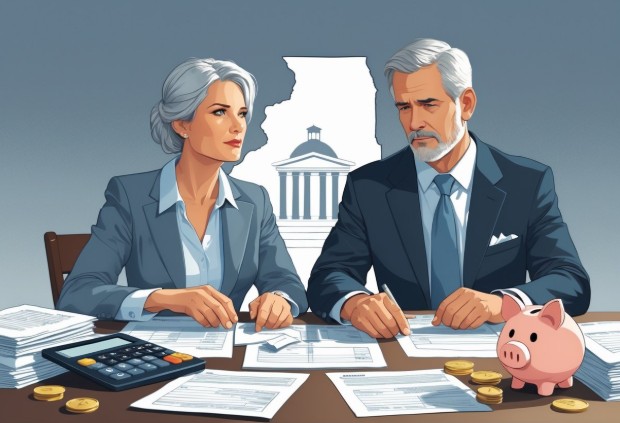Divorce in Illinois? It’s no longer just a courtroom drama with two sides battling it out. Welcome to the world of collaborative divorce, where mediation is the new superhero, swooping in to save the day (and sanity) for couples seeking a more harmonious split. Imagine this: instead of a cold, adversarial process, there’s a warm, coffee-table conversation where both parties actually listen and work together. Sounds almost too good to be true, right?
In the heart of Illinois, mediation in collaborative divorce is rewriting the story of separation. It’s less about winners and losers and more about finding a middle ground where everyone’s voice is heard.
Think of it as a group project where the assignment is to untangle years of shared life with respect and dignity. Easy? Not exactly. But with the right mediator, it’s like having a guide through an emotional maze, offering tissues for the tears and high-fives for the breakthroughs.
The Role of Mediation in Illinois Divorce Law
Emphasizing Emotional Intelligence and Communication
One of the distinct aspects of mediation in Illinois is its emphasis on emotional intelligence and effective communication. Unlike the court-driven process, which often centers on legal arguments and evidence, mediation encourages spouses to engage in open dialogue, facilitated by a trained mediator.
Customized Solutions Beyond Legal Boundaries
Illinois law recognizes the power of mediation to offer customized solutions that may not be feasible in a courtroom setting. Mediators in Illinois are skilled at navigating beyond the rigid confines of legal statutes to explore creative resolutions tailored to the unique needs of each family.
Addressing Complex Financial and Legal Issues with Expertise
Lastly, mediation in Illinois is not limited to just resolving emotional or parenting issues. Mediators often bring in financial and legal specialists to assist in complex situations, such as high-asset divorces or intricate business valuations. This interdisciplinary approach ensures that the agreements reached are not only emotionally satisfactory but also financially sound and legally compliant
The Process of Mediation in Collaborative Divorce
The process of mediation in a collaborative divorce is marked by structured yet flexible stages, designed to facilitate a fair and amicable resolution.
Initial Consultation and Agreement
The process typically begins with an initial consultation where the mediator explains the rules and goals of mediation. Both parties sign an agreement that outlines the confidentiality of the process and their commitment to openly participate.
Information Gathering and Setting Goals
Mediators help couples to articulate their individual goals and concerns. This step involves in gathering financial data, parenting needs and other important information.
Exploring Options and Negotiating Agreements
Through a series of joint and sometimes separate sessions, the mediator assists the couple in exploring various options and alternatives.
Drafting the Agreement
Once the parties reach an agreement, the mediator drafts a document that encapsulates all the terms.
Finalization and Legal Approval
The final step involves the legal formalization of the agreement. the documents to the court for approval, and entry of a divorce judgment, making it a legally binding document.
Selecting the Right Mediator: Qualifications and Skill
The selection of a mediator in the context of a collaborative divorce is a critical step that can significantly influence the outcome.
Expertise beyond Basic Mediation Training
While basic mediation training is fundamental, the ideal mediator for a divorce case in Illinois should possess training and experience in family law.
Emotional Intelligence and Communication Skills
A mediator’s qualifications should extend beyond legal and technical knowledge. Emotional intelligence and strong communication skills are vital.
Cultural Competence and Sensitivity
In a diverse state like Illinois, cultural competence is a critical qualification for a mediator. The mediator should understand and respect the cultural backgrounds, beliefs, and values of the couples they work with.
Preparing for Mediation: Steps for Couples in Illinois
Preparation is key for couples in Illinois embarking on mediation. Proper preparation can make the process smoother and more effective.
Understanding the Legal Landscape
Couples should begin by familiarizing themselves with the legal aspects of divorce in Illinois.
Setting Personal Goals and Priorities
Before entering mediation, each individual should reflect on their personal goals and priorities post-divorce. This introspection helps in identifying what matters most and what they are willing to compromise on. Clear personal goals guide the mediation process towards outcomes that align with each individual’s long-term well-being.
Emotional Preparedness
Emotional preparedness is often overlooked but is crucial for a productive mediation process. Couples should consider seeking support from counselors or therapists to address any emotional challenges related to the divorce.
Open Communication
Finally, couples should commit to open and honest communication during the mediation process.
The Legal Framework Supporting Mediation in Illinois
In Illinois, the legal framework surrounding mediation reflects a progressive approach to dispute resolution in family law.
Legislation Endorsing Mediation
Illinois law, through various statutes, explicitly recognizes and endorses mediation.
Confidentiality Protections
A pivotal aspect of the legal framework in Illinois is the emphasis on confidentiality. The laws ensure that communications during mediation sessions are protected. This confidentiality encourages open and honest dialogue, as parties can speak freely without fear that their words will be used against them in court should mediation not result in an agreement.
Court-Ordered Mediation
In certain cases, Illinois courts have the authority to order mediation, especially in disputes involving child custody and visitation.
Overcoming Challenges and Deadlocks in Mediation
Despite its many benefits, mediation can encounter challenges and deadlocks. Addressing these effectively is crucial for the success of the mediation process.
Handling Emotional Volatility
Divorce mediation often involves high emotions.Skilled mediators in Illinois are trained to handle emotional volatility.
Bridging Communication Gaps
Communication breakdowns are common in divorce situations. Mediators facilitate by ensuring that each party is heard and understood. They help translate and clarify positions, preventing misunderstandings that can lead to impasses.
Creative Problem-Solving
When traditional solutions don’t suffice, mediators in Illinois often employ creative problem-solving techniques.
Involving Professionals and Advisors
In complex cases, such as those involving complicated financial matters or child welfare concerns, mediators may involve other professionals or advisors.
Patience and Persistence
Overcoming challenges in mediation often requires patience and persistence. The process is not always linear and may require multiple sessions to reach a resolution.

Mediation vs. Litigation: Understanding the Differences
The choice between mediation and litigation in divorce proceedings represents two fundamentally different approaches.
Approach and Environment
The most striking difference lies in the approach and environment of the two processes.Mediation is collaborative, aiming to create a mutually beneficial outcome through cooperative negotiation.The environment is informal and private, conducted in a neutral space without the formalities of a courtroom.
Litigation, on the other hand, is adversarial by nature. It takes place in a public courtroom and follows a formal, often rigid, legal process.
Control and Flexibility
In mediation, couples maintain control over the outcome.They work together to reach an agreement that works for both parties, with the mediator facilitating rather than directing the process.
Litigation, on the other hand, places the decision-making power in the hands of a judge. The outcomes are more unpredictable and bound by legal precedents and statutes.
Time and Cost
Mediation typically offers a quicker resolution than litigation. This expediency often results in lower costs compared to the extended and expensive nature of litigation.
Emotional Impact
The emotional impact of mediation versus litigation cannot be overstated. Mediation encourages respectful communication and can often preserve a cordial post-divorce relationship, which is especially beneficial when children are involved. Litigation, with its confrontational nature, often exacerbates conflict and emotional stress.
Finalizing the Divorce Agreement
Once mediation successfully concludes, there are critical steps to finalize the divorce agreement, ensuring that the decisions made are legally binding and enforceable.
Reviewing and Drafting the Agreement
The first step is the drafting of the mediation agreement. The agreement captures all the decisions made during mediation sessions.
Legal Formalization
The next step is the legal formalization of the agreement. In Illinois, this involves submitting the mediation agreement to the court. The agreement needs to be put into a legal format acceptable to a judge. In most mediated divorce at least one of the spouses hires an attorney to prepare the legal documents and guide them through the divorce process. The legal documents are reviewed by a judge and, if deemed fair and in accordance with state laws, are incorporated into the final divorce decree.
Implementation and Compliance
Post-approval, the focus shifts to the implementation of the agreement. This includes dividing assets, arranging for alimony or child support payments, and implementing the agreed-upon child custody arrangements.
Addressing Future Changes
Life circumstances can change, necessitating modifications to the agreement. In Illinois, post-divorce modifications can be made, but they typically require legal action unless both parties agree to the changes and they are in the best interests of any children involved.
Navigating Child Custody and Support in Mediation
When it comes to divorce, the aspects of child custody and support are often the most emotionally charged and complex.
Child-Centric Approach in Mediation
Mediation shifts the focus from a parent-centric to a child-centric approach. Unlike traditional litigation, which often inadvertently places children in the middle of conflict, mediation encourages parents to collaboratively decide on arrangements that foremost benefit their children.
Developing a Flexible Custody Plan
One of the key advantages of mediation is the ability to create flexible and creative custody arrangements. Mediators help parents explore various custody options that are not typically available in a court ruling. These can include joint custody, nesting arrangements (where children stay in one home and parents alternate), or customized schedules that align with the family’s unique lifestyle and the children’s needs.
Addressing Emotional and Developmental Needs
Mediators with expertise in child development can guide parents in understanding and considering their children’s emotional and developmental needs during the decision-making process.
Contingency Planning for Future Changes
Life circumstances can change, and mediation allows for the discussion and incorporation of contingency plans in the custody and support agreements. This might include provisions for relocation, changes in financial situations, or adjustments needed as children grow older.
Addressing Financial and Property Issues in Mediation
Emphasizing Fairness and Transparency
A key principle in mediation is the emphasis on fairness and transparency. Unlike in court, where financial decisions can be more formulaic, mediation allows couples to openly discuss and negotiate the division of assets, debts, and property.
Balancing Emotional and Financial Decisions
Financial and property issues in divorce are often intertwined with emotional considerations. Mediation allows for a balanced approach where emotional aspects, like attachment to certain assets or concerns about financial security post-divorce, are acknowledged and addressed.
Planning for Future Financial Stability
An often-overlooked advantage of mediation is the opportunity to plan for future financial stability.
Involving Financial Experts
In complex cases, mediators may suggest involving financial professionals such as accountants, financial advisors, or appraisers.
Ensuring Legal Validity
Once a financial agreement is reached, it is typically formalized through legal processes, making it enforceable.
Positive Impact of Mediation on Children and Families
Promoting a Child-Centered Approach
A significant benefit of mediation is its inherent child-centered approach. The focus helps in minimizing the trauma often associated with divorce, ensuring that children feel secure and considered throughout the process.
Reducing Exposure to Conflict
Mediation, by nature, is less adversarial than court battles. This reduced exposure to conflict is immensely beneficial for children. In a mediation setting, parents are more likely to engage in respectful communication and collaborative problem-solving. Children are thus shielded from the harmful effects of witnessing parental conflict, which is often inevitable in litigated divorces.
Enhancing Family Adjustment Post-Divorce
The collaborative nature of mediation aids in smoother family adjustment post-divorce. Since agreements are reached mutually, there’s often less resentment and more willingness to adhere to the terms.
Long-Term Positive Outcomes for Children
Research has shown that children whose parents resolve their divorce through mediation exhibit fewer adjustment problems compared to those whose parents underwent contentious divorces.
Mediation, therefore, is not just a method for dissolving a marriage; it’s a pathway to preserving the integrity and health of the family structure amidst change.
Transform Your Family’s Future: Choose Clarity Over Conflict with Anna Krolikowska
Life’s challenges don’t come with a guidebook, especially when it involves family matters. But with Anna Krolikowska, you’re not just getting a lawyer, you’re partnering with a mediator, an advocate, and a problem-solver rolled into one.
Whether it’s navigating the nuances of divorce, untangling child custody complexities, or addressing support issues, Anna brings a compassionate yet pragmatic approach.
Her expertise extends beyond the courtroom, offering mediation, collaborative law, and even prenuptial agreements, ensuring every aspect of your family’s journey is handled with care and precision. It’s not just about legal solutions; it’s about peace of mind and a pathway to a better future.
Step into a brighter future. Contact Anna Krolikowska now for compassionate guidance.

People Also Ask
What is the role of mediation in collaborative divorce in Illinois?
Mediation in collaborative divorce serves as a bridge between both parties, facilitating a cooperative and constructive dialogue. It aims to create mutually beneficial agreements while minimizing conflict and emotional distress.
How does mediation differ from traditional divorce proceedings in Illinois?
Unlike traditional divorce, where decisions are often made in court, mediation involves a neutral third party who helps couples reach agreements outside of court, fostering a more amicable and less adversarial process.
Is mediation in collaborative divorce legally binding in Illinois?
The agreements reached in mediation can become legally binding once they are formalized and approved by a court. However, the mediation process itself is not legally binding, allowing flexibility for parties to negotiate terms.
Can mediation handle complex issues like child custody and financial settlements in Illinois?
Yes, mediation can address complex issues such as child custody and financial settlements. It allows couples to discuss and resolve these matters in a more personalized and detailed manner than might be possible in a traditional court setting.
What are the benefits of choosing mediation in a collaborative divorce in Illinois? The benefits include reduced emotional stress, greater control over outcomes, often lower costs compared to court battles, and the preservation of a cooperative relationship, especially important when children are involved.
























